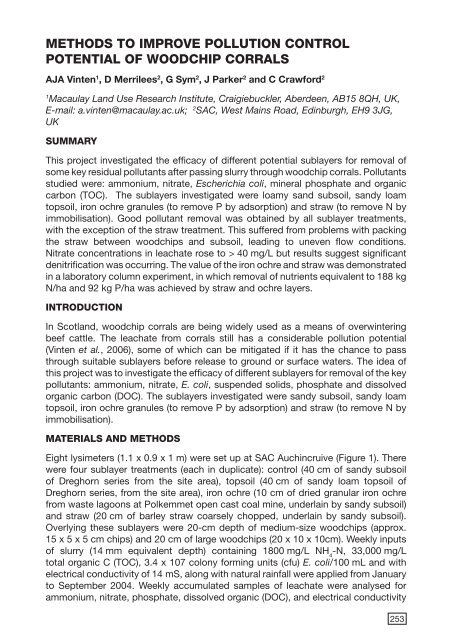Download as a PDF - CiteSeerX
Download as a PDF - CiteSeerX
Download as a PDF - CiteSeerX
Create successful ePaper yourself
Turn your PDF publications into a flip-book with our unique Google optimized e-Paper software.
METHODS TO IMPROVE POLLUTION CONTROL<br />
POTENTIAL OF WOODCHIP CORRALS<br />
AJA Vinten 1 , D Merrilees 2 , G Sym 2 , J Parker 2 and C Crawford 2<br />
1<br />
Macaulay Land Use Research Institute, Craigiebuckler, Aberdeen, AB15 8QH, UK,<br />
E-mail: a.vinten@macaulay.ac.uk; 2 SAC, West Mains Road, Edinburgh, EH9 3JG,<br />
UK<br />
SUMMARY<br />
This project investigated the efficacy of different potential sublayers for removal of<br />
some key residual pollutants after p<strong>as</strong>sing slurry through woodchip corrals. Pollutants<br />
studied were: ammonium, nitrate, Escherichia coli, mineral phosphate and organic<br />
carbon (TOC). The sublayers investigated were loamy sand subsoil, sandy loam<br />
topsoil, iron ochre granules (to remove P by adsorption) and straw (to remove N by<br />
immobilisation). Good pollutant removal w<strong>as</strong> obtained by all sublayer treatments,<br />
with the exception of the straw treatment. This suffered from problems with packing<br />
the straw between woodchips and subsoil, leading to uneven flow conditions.<br />
Nitrate concentrations in leachate rose to > 40 mg/L but results suggest significant<br />
denitrification w<strong>as</strong> occurring. The value of the iron ochre and straw w<strong>as</strong> demonstrated<br />
in a laboratory column experiment, in which removal of nutrients equivalent to 188 kg<br />
N/ha and 92 kg P/ha w<strong>as</strong> achieved by straw and ochre layers.<br />
INTRODUCTION<br />
In Scotland, woodchip corrals are being widely used <strong>as</strong> a means of overwintering<br />
beef cattle. The leachate from corrals still h<strong>as</strong> a considerable pollution potential<br />
(Vinten et al., 2006), some of which can be mitigated if it h<strong>as</strong> the chance to p<strong>as</strong>s<br />
through suitable sublayers before rele<strong>as</strong>e to ground or surface waters. The idea of<br />
this project w<strong>as</strong> to investigate the efficacy of different sublayers for removal of the key<br />
pollutants: ammonium, nitrate, E. coli, suspended solids, phosphate and dissolved<br />
organic carbon (DOC). The sublayers investigated were sandy subsoil, sandy loam<br />
topsoil, iron ochre granules (to remove P by adsorption) and straw (to remove N by<br />
immobilisation).<br />
MATERIALS AND METHODS<br />
Eight lysimeters (1.1 x 0.9 x 1 m) were set up at SAC Auchincruive (Figure 1). There<br />
were four sublayer treatments (each in duplicate): control (40 cm of sandy subsoil<br />
of Dreghorn series from the site area), topsoil (40 cm of sandy loam topsoil of<br />
Dreghorn series, from the site area), iron ochre (10 cm of dried granular iron ochre<br />
from w<strong>as</strong>te lagoons at Polkemmet open c<strong>as</strong>t coal mine, underlain by sandy subsoil)<br />
and straw (20 cm of barley straw coarsely chopped, underlain by sandy subsoil).<br />
Overlying these sublayers were 20-cm depth of medium-size woodchips (approx.<br />
15 x 5 x 5 cm chips) and 20 cm of large woodchips (20 x 10 x 10cm). Weekly inputs<br />
of slurry (14 mm equivalent depth) containing 1800 mg/L NH 4<br />
-N, 33,000 mg/L<br />
total organic C (TOC), 3.4 x 107 colony forming units (cfu) E. coli/100 mL and with<br />
electrical conductivity of 14 mS, along with natural rainfall were applied from January<br />
to September 2004. Weekly accumulated samples of leachate were analysed for<br />
ammonium, nitrate, phosphate, dissolved organic (DOC), and electrical conductivity<br />
253

















